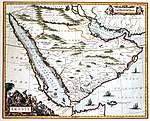Ghiyathiyyah Madrasah
Ghiyathiyyah Madrasah (Arabic: مدرسة الغياثية, romanized: Madrasah Al-Ghiyāthiyyah, lit. 'Madrasas of Ghiyath'), later known as Bangaliyyah Madrasah (Arabic: بنجالية مدرسة, romanized: Madrasah Al-Banjāliyyah, lit. 'Bengali Madrasas'), refers to the madrasas constructed in Hejaz during the 14th-15th century by the Sultans of Bengal.[1] Part of a history of interactions between the Bengal Sultanate and Sharifate of Mecca, an account of these can be found in the Tarikh Makkah (History of Makkah).[2]
Part of a series on the |
|---|
| History of Saudi Arabia |
 |
|
|
Histrory
Sultan Ghiyathuddin Azam Shah founded two institutes in Makkah and Madinah during his reign in Bengal from 1390 to 1411.[3] The Madrasah as-Sultaniyyah al-Ghiyathiyyah al-Banjaliyah of Makkah was located near the gate of Umm Hani of Masjid al-Haram. Construction began in Ramadan 1411 CE and was completed in 1412 CE. The contemporary Arab scholar Taqi al-Din Muhammad ibn Ahmad al-Fasi worked in this madrasa as teacher of Maliki fiqh and other teachers included Jamal ad-Din Qarshi, Shihab ad-Din Saghani, Muhy ad-Din Fasi, Abul Hasan al-Haskafi and the Shibi family. The curriculum of the institution taught fiqh from all different madhhabs.[4] The Ghiyathiyyah of Madinah was situated near Bab as-Salam in Al-Masjid an-Nabawi. The Sultan also commissioned money to buy property for establishing and to maintain both of these institutes. He sent a lot of money to repair the Arafat Stream. However, the Sharif of Makkah, Hasan ibn Ajlan, decided to use the money given by the Sultan for another project instead.[5] The madrasas were said to be the best institutions in the region during this period.[1]
A later Sultan of Bengal, Jalaluddin Muhammad Shah, had good relations with Barakat ibn Hasan, the Sharif of Makkah, sent him presents and robes of honour.[5] The Sultan gained permission from the Sharif to construct a madrasah in the city of Makkah. He is also said to have constructed a madrasah in Madinah between 1428 and 1431.[6][4]
See also
References
- Abdul Karim (2012). "Ghiyasia Madrasa". In Islam, Sirajul; Miah, Sajahan; Khanam, Mahfuza; Ahmed, Sabbir (eds.). Banglapedia: the National Encyclopedia of Bangladesh (Online ed.). Dhaka, Bangladesh: Banglapedia Trust, Asiatic Society of Bangladesh. ISBN 984-32-0576-6. OCLC 52727562. Retrieved 29 July 2020.
- Green, Nile, ed. (2019). The Persianate World: The Frontiers of a Eurasian Lingua Franca. University of California Press. p. 100.
- Mahmudur Rahman (2018). The Political History of Muslim Bengal: An Unfinished Battle of Faith. Cambridge Scholars Publishing. p. 14.
- Siddiq, Mohammad Yusuf (2015). Epigraphy and Islamic Culture: Inscriptions of the Early Muslim Rulers of Bengal (1205-1494). Routledge.
- Farooqi, Naimur Rahman (1989). Mughal-Ottoman relations: a study of political & diplomatic relations between Mughal India and the Ottoman Empire, 1556-1748. Delhi: Idarah-i Adabiyat-i Delli. pp. 110–111.
- MA Taher (2012). "Jalaluddin Muhammad Shah". In Islam, Sirajul; Miah, Sajahan; Khanam, Mahfuza; Ahmed, Sabbir (eds.). Banglapedia: the National Encyclopedia of Bangladesh (Online ed.). Dhaka, Bangladesh: Banglapedia Trust, Asiatic Society of Bangladesh. ISBN 984-32-0576-6. OCLC 52727562. Retrieved 29 July 2020.